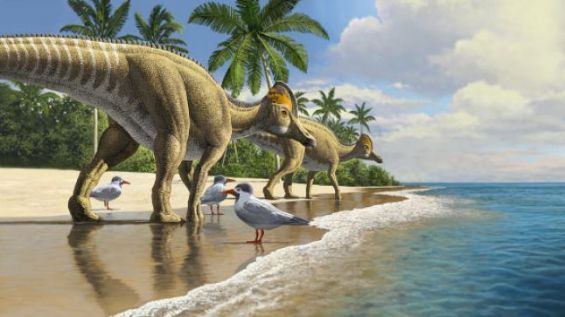A dinosaur that once lived in Morocco is believed to have crossed oceans to get to its destination, researchers say. The remains of the duckbilled dinosaur were found in the Office Chérifien des Phosphates mines at Sidi Chennane in the Moroccan province of Khouribga.
«The discovery of the new fossil in a mine a few hours from Casablanca was about the last thing in the world you would expect», said lead author Dr. Nicholas Longrich, a paleontologist in the Milner Centre for Evolution at the University of Bath.
«It was completely out of place, like finding a kangaroo in Scotland. Africa was completely isolated by water — so how did they get there?», he asked.
The newly discovered species, dubbed Ajnabia odysseus, lived some 66 million years ago during the Maastrichtian age of the Late Cretaceous epoch. The dinosaur is a plant-eating animal from the Hadrosauridae family. Ajnabia, which stands for «foreign», is a 3-meter long dinosaur that evolved in North America before immigrating to Asia and Europe.
A dinosaur that swam to Africa
However, it is the first time ever that the dinosaur is found in Africa, more precisely in Morocco. According to scientists, it would have been impossible 66 million years ago for the dinosaur to walk to Africa. In this case, Ajnabia would have swum to Africa.
«It was impossible to walk to Africa. These dinosaurs evolved long after continental drift split the continents, and we have no evidence of land bridge», Longrich said.
«The geology tells us Africa was isolated by oceans. If so, the only way to get there is by water. As far as I know, we’re the first to suggest ocean crossings for dinosaurs».
The reason why the dinosaur is compared to a duck is the fact that it was probably a powerful swimmer with a large tail, powerful legs. It is believed that they would have crossed hundreds of miles of water «either rafting on derbies, floating or swimming», to reach North Africa.
Dr Nour-Eddine Jalil, from the Natural History Museum of Sorbonne University, describes finding the fossil of a terrestrial animal in a marine environment as a «succession of improbable events». The discovery «highlights the rarity of our finding and therefore its importance», he said.
«Ajnabia shows us that hadrosaurs have set foot on African land, telling us that ocean barriers are not always an insurmountable obstacle», he concluded.
For the record, the findings were published by peer-reviewed journal Science Direct in a study entitled «The first duckbill dinosaur (Hadrosauridae: Lambeosaurinae) from Africa and the role of oceanic dispersal in dinosaur biogeography».




 chargement...
chargement...












